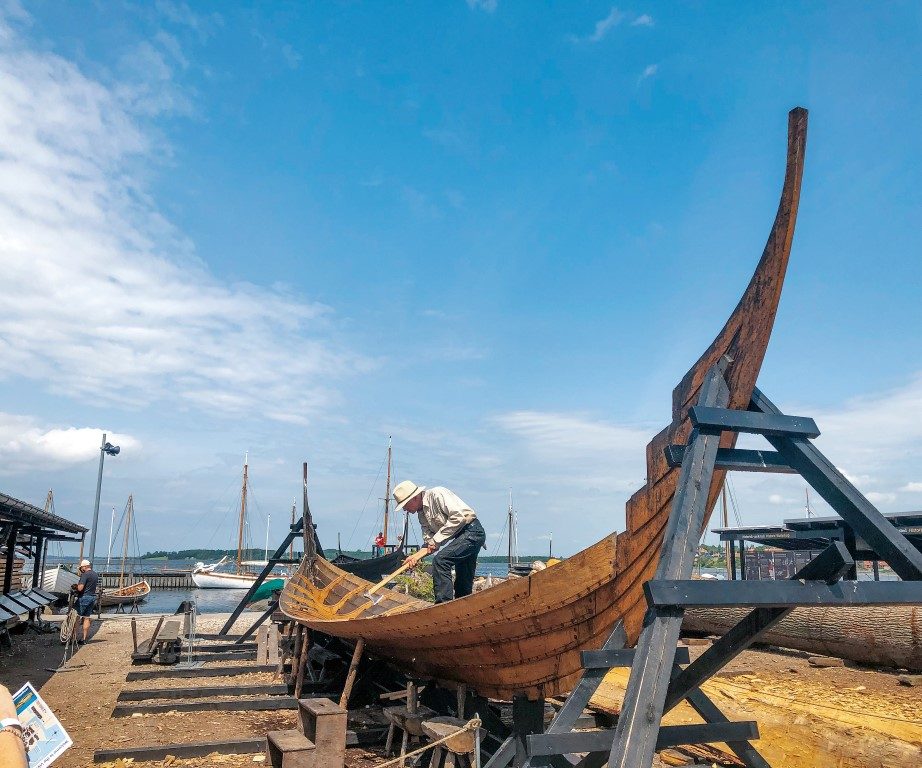

The charming city of Roskilde is half an hour by train from Denmark’s capital city, Copenhagen. Situated on the island of Zealand at the head of Roskilde Fjord, Roskilde was supposedly founded in the 980s by Harald Bluetooth.
It is one of Denmark’s oldest cities and was the seat of the Danish kings before the capital was moved to Copenhagen in 1443. Thirty-nine Danish monarchs are entombed in Roskilde’s UNESCO-listed 13th Century Gothic cathedral and its Victorian railway station, completed in 1847, is the oldest still operational in Denmark.
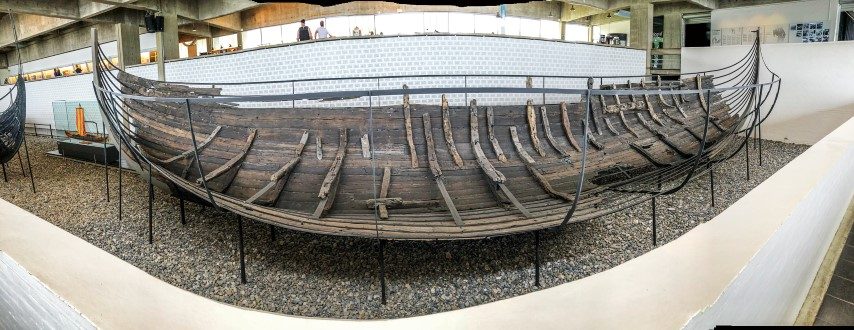
Like so many visitors, Megan and I took the train to Roskilde to visit the city’s famed Viking Ship Museum. The weather was pleasant, so walking the couple of kilometres from the railway station on the hill to the museum beside the water was no hardship. The route is well-signposted, the attractive suburban streets are nicely kept, and the descent is gentle. Other transport options include bus and private car.
The museum overlooking the inlet was built in 1969 to house the remains of five 11th Century Viking ships excavated from the fjord at Skuldelev in 1962. The main building contains the original Skuldelev ships, but excavations to extend the complex in the 1990s uncovered a further nine Viking-era vessels. They include the longest Viking warship ever found (36m), the Roskilde 6.
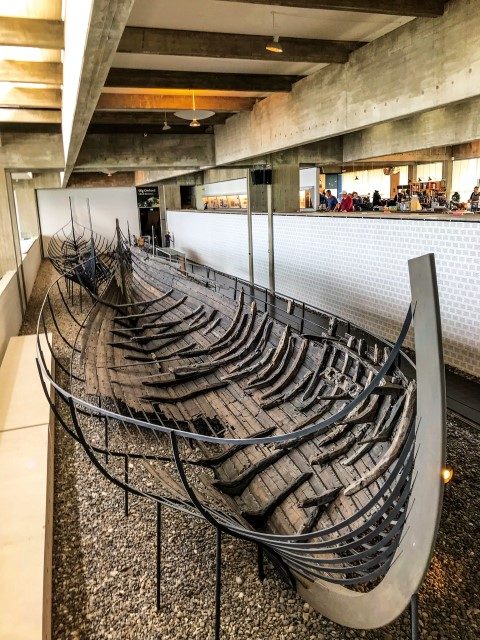 The best-preserved ship is Skuldelev 3, a 14m oak-built cargo ship of the byrding type with a beam of 3.3m and a cargo capacity of 3-4 tonnes. A short-range Baltic trader drawing less than a metre, it was constructed somewhere in Denmark around 1040. It would have carried a crew of between five and eight and a woollen square sail of around 45m², giving it a best speed of maybe 10 knots. 75% of Skuldelev 2 has been preserved.
The best-preserved ship is Skuldelev 3, a 14m oak-built cargo ship of the byrding type with a beam of 3.3m and a cargo capacity of 3-4 tonnes. A short-range Baltic trader drawing less than a metre, it was constructed somewhere in Denmark around 1040. It would have carried a crew of between five and eight and a woollen square sail of around 45m², giving it a best speed of maybe 10 knots. 75% of Skuldelev 2 has been preserved.
Skuldelev 6 is a hybrid type that’s neither a dedicated cargo vessel nor a warship. It had a good cargo capacity and a usefully shallow 0.5m draught. Built in in Sognefjorden, Western Norway, from pine in about 1030, its original purpose may have been fishing. It was somewhat rebuilt later in life to serve as a small coastal cargo vessel. It would have had a crew of 5-15, depending on its role.
Some 70% of Skuldelev 6 has survived and the museum has replicated it twice, creating Kraka Fyr in 1998 and Skjoldungen in 2010. Both can be sailed on the waters of the fjord.
Of the other ships, Skuldelev 1, a knarr or cargo ship built in pine, also in Sognefjord, is the next-best preserved. Eleven metres long with a beam of 4.8m and drawing around a metre, this ship would have plied the waters of the Baltic, North Sea and Atlantic Ocean. During its life, spent in Oslo Fjord and then Denmark, it was repaired several times using planks of oak and linden.
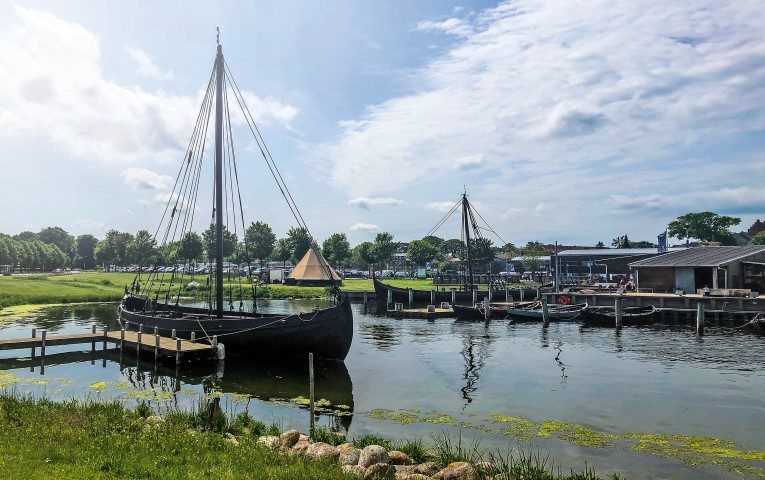
A knarr needed a crew of six or eight. A single 90m² sail gave Skuldelev 1 a top speed of around 13 knots, but considerably less under oars, of which there were no more than four. About 60% of this ship has been preserved. It has been replicated by the museum as the ship Ottar, which is available to sail.
Skuldelev 5 is a small warship of the snekkja type. With a length of 17.5m and a very shallow 0.6m draught, her 30-man crew would have been able to travel far upriver and raid areas closed to ships with deeper draughts. Built near Roskilde of oak, pine, ash and alder, Skuldelev 5 was meant for the shallow Danish waters of the Baltic Sea.
With 46m² of sail the vessel would have averaged around 6-7 knots under sail, with a maximum speed of perhaps 13 knots. This ship is 50% intact and its replica at Roskilde is Helge Ask. An earlier replica, Sebbe Als, built in 1969 in Augustenborg, reaches speeds of 5 knots under oars and 12 knots under sail.
The museum’s outdoor displays include a working boat yard, which builds and exhibits full scale replicas of the ships. Visitors can watch craftsmen recreating Viking-era vessels and making ship’s cordage using traditional techniques. There is also a dedicated children’s museum and a working smithy.
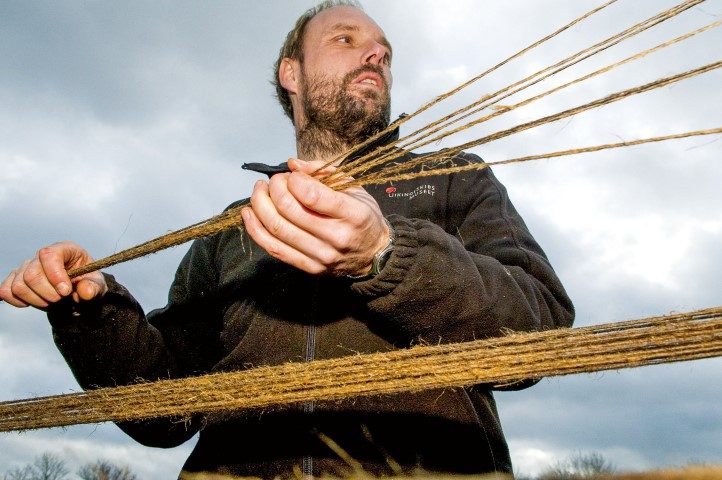
You can even enjoy a range of foods based on traditional Viking ingredients served in the well-priced on-site restaurant or try your hand at a range of Viking sports and amusements – of the more genteel variety with no weapons involved!
Viking shipbuilding
While the ships and other displays inside the museum are fascinating, we enjoyed the outside exhibits just as much, especially the boat yard. Surrounded by moored Viking-Age vessels, the open-air boat yard is where you can see replica ships and boats under construction.
Boatbuilding work goes on every day the weather allows; when it’s too cold, the craftsmen retreat under cover to the boat shed. The workshop is festooned with the traditional tools of Norse boatbuilding, with nary a power tool to be seen.
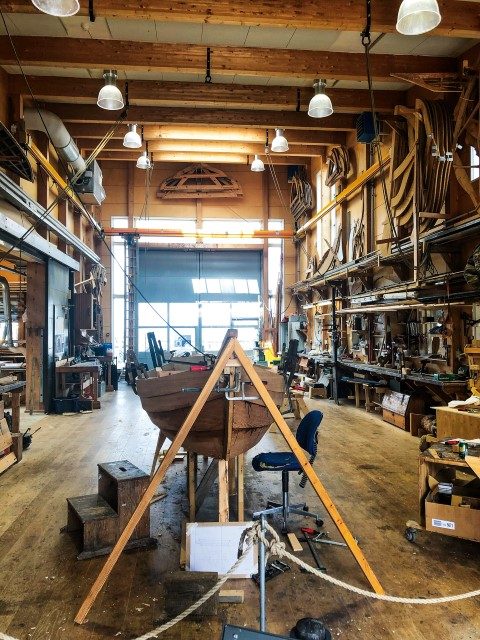 Viking ships were the pinnacle of technology in their day, representing wealth and status for their owners and transporting men, animals and cargo on long ocean voyages. Their primacy at sea went unchallenged for hundreds of years and ships of this type were still used in the Scottish Isles well into the 1700s and survived in the Orkney and Faroe Islands until the 19th Century. Their influence is still seen today in the wooden boatbuilding traditions of Scandinavia, the UK, North America and elsewhere.
Viking ships were the pinnacle of technology in their day, representing wealth and status for their owners and transporting men, animals and cargo on long ocean voyages. Their primacy at sea went unchallenged for hundreds of years and ships of this type were still used in the Scottish Isles well into the 1700s and survived in the Orkney and Faroe Islands until the 19th Century. Their influence is still seen today in the wooden boatbuilding traditions of Scandinavia, the UK, North America and elsewhere.
Fast, light and remarkably seaworthy, such ships carried Norse seafarers, raiders, traders and colonists to the Americas, Greenland, Iceland, Spain, Italy and Turkey. Viking raiders even used the great rivers to penetrate deep into Russia (which is named after them – Rus was the Slavic name for Norsemen), establishing the kingdom of Kievan Rus which lasted more than 350 years.
From around 750 until 1100 the sight of approaching Norse dragon ships was enough to freeze the blood in the veins of anyone ashore, whether Christian, Muslim or Pagan.
Viking ships were built from unseasoned (green) wood, usually oak (preferred), larch, pine, ash, elm or spruce. The timber was often worked wet and partially built ships or parts of ships were sometimes sunk in bogs or buried in mud to stop them drying out over winter. Wet timber was easier to work and easier to force into shape. Once dry, the shapes would set. At the bow and stern, builders were able to fashion compound curves at the waterline, resulting in fine entries.
Ships were clinker (lapstrake) built, right way up, starting with the keel. Keel and stems were built first, as demonstrated in the boat yard at Roskilde. The keel was usually made from several lengths of timber spliced together and fastened with treenails (wooden dowels or pegs). It was shaped to take the garboard planks.

Next came the strakes, lines of planks laid end to end from stem to stern, usually butt-joined but sometimes scarfed and nailed. Strakes were radially hewn, where the log is first quartered lengthwise before planks are hewn from the flat faces so that the grain is approximately at right angles to the face of the plank.
This results in stronger, more flexible timbers with an even rate of expansion and contraction in water. The planks are similar to modern ‘quarter-sawn’ timber, which has the least shrinkage of any cut section of wood. Each strake overlapped the strake below it by 25-30mm, the overlaps stuffed with wool, hair or hemp soaked in pine tar and secured by iron rivets.
Once the strakes reached the required height the futtocks (interior frames) were added, along with cross beams. Futtocks next to keel were fashioned from natural L-shaped crooks. Futtocks were designed to allow the hull a certain amount of twist and all the different parts were held together by iron rivets hammered in from outside and fastened inside with a rove. Later ships had spruce stringers fastened lengthways to the futtocks. Ships were coated inside and out with tar (resin) which was left over winter to dry.
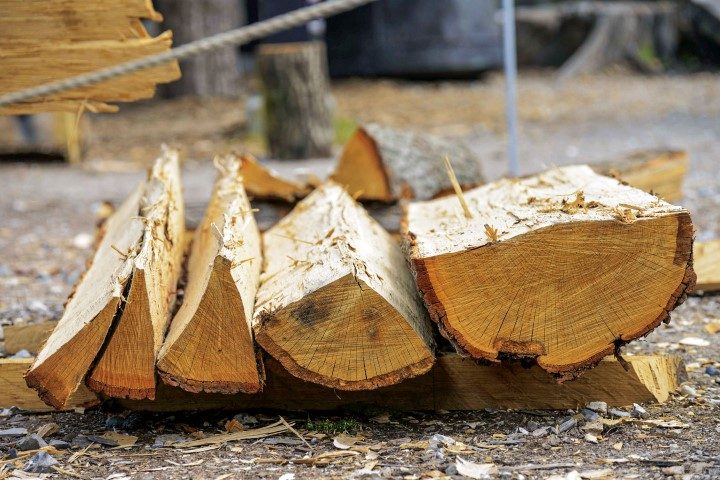
Shipbuilders used adzes and axes, hammers, mallets, wedges, draw knives, chisels, augurs, awls, gouges, twist-drills, snips and planes. Saws were rare.
Square sails were made from rough woollen cloth (women of every class wove wool), stitched for smaller vessels like knarrs, unstitched in longships. Cordage was fashioned from hemp, flax and hide (often walrus). Spars were usually pine.
The ship’s mast was stepped in a kerling (‘old woman’ in Old Norse) made of oak laid across two strong frames above the keel in the centre of the boat, augmented by the ‘mast fish’ just below deck height – later an athwartships beam as in modern craft. The mast fish was a thick timber baulk up to 3m long aligned fore and aft with a slot facing aft to accommodate the stepped mast.
Once erect, the mast was secured with side stays secured via loops and a toggle to futtocks and tightened using a wooden turn-block/multi v-jam cleat variously called an angel, virgin or maiden. About four turns of rope were taken around the angel’s wings and jammed in the v to secure the stay. They probably also had stays fore and aft, as the modern replicas do.

Masts were up to 16m tall, but never more than half the length of the ship, so they could be lowered with the mast foot resting in the mast step and the mast resting on a crook on the port side (so as not to interfere with steering the boat from the starboard side).
A beitass or stretching pole was a wooden spar used to stiffen the sail. It kept the luff taut, which made tacking easier. In modern replicas, sail and mast can be lowered in around 90 seconds.
A steering oar on the starboard side was used in early vessels, but later ships had a pivoting side rudder or ‘steerboard’, its shaft passing through a drilled wooden block halfway down the starboard topsides aft fixed at the gunwale by a u-shaped joint. The steerboard could be adjusted for height to operate in shallow water; a removable tiller was pushed into one of two holes in the head of the rudder stock, depending on whether the board was set shallow or deep.
Oars were used to take ships into battle, for coastal and river travel, and whenever the wind was insufficient or unfavourable. Rowers sat on benches or more often on their sea chests to man the oars and sometimes rowed two to an oar if extra speed was required. Norse ships used holes cut below the gunwale line to take the oars, sometimes in conjunction with hooks or loops of rope to keep them in place. When sailing, oar holes were covered with wooden discs to keep the water out.




